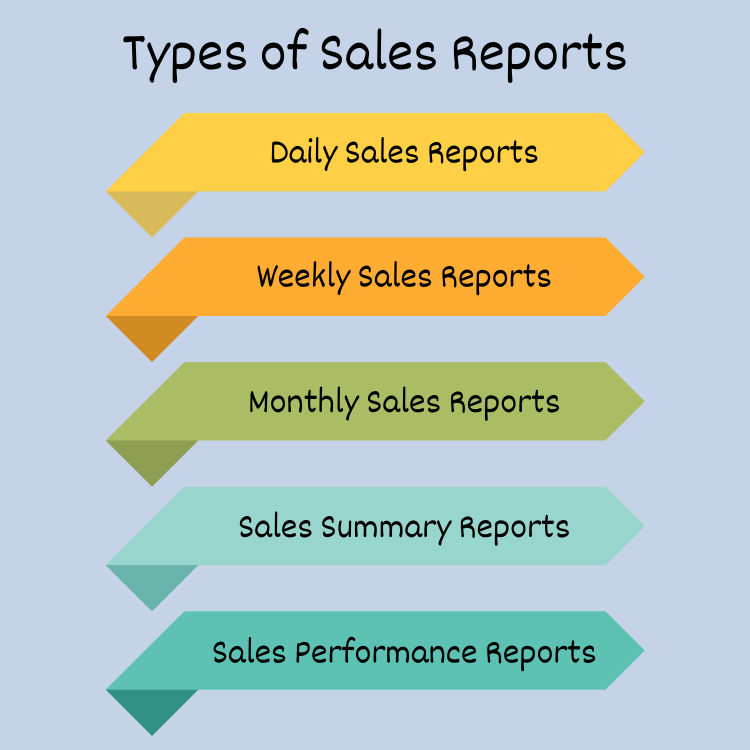The Ultimate Guide to Sales Reports: Examples, Templates, and How to Create Them [2024]
Learn how to create clear and actionable sales reports with examples, templates, and expert tips to drive business growth.
Learn how to create clear and actionable sales reports with examples, templates, and expert tips to drive business growth.

Sales reports are more than just an operational necessity—they’re the roadmap to smarter decisions, sharper strategies, and higher sales. Whether you’re tracking daily performance, analyzing product trends, or presenting results to stakeholders, a well-crafted sales report can reveal powerful insights to fuel your business growth.
This guide will show you how to create actionable sales reports that go beyond the basics, using examples, templates, and practical tips. By the end, you’ll know exactly how to turn raw data into meaningful insights that help you hit your revenue goals, identify top-performing products, and stay ahead of the competition.
A sales report is a document that summarizes your business’s sales activities, performance, and trends over a specific period. It helps you understand how your sales efforts are progressing, whether you’re meeting targets, and where adjustments might be needed.
Sales reports provide a snapshot of key metrics like revenue, units sold, and customer behavior. They are essential for tracking sales performance and making informed decisions to improve strategies.

Different sales reports serve different purposes. Here are the most common types:
Each type of report plays a critical role in effective sales management, ensuring that you can adjust your strategies promptly and maximize results.
Sales Reports aren’t just numbers on a page—they’re the foundation for making smarter decisions in your business. By tracking and analyzing sales data, you can uncover trends, measure progress toward goals, and identify areas for improvement.
Here’s why sales reporting is essential:
A well-structured sales report shows whether your team is hitting its targets. It highlights performance against goals, helping you understand where you’re excelling and where you need to make adjustments.
Sales reports reveal patterns in customer purchases, preferences, and buying cycles. By analyzing these trends, you can refine your sales strategy to align with customer needs and drive higher conversions. Learn more about understanding customer behavior in your ecommerce sales funnel.
A product sales report pinpoints which offerings generate the most revenue. This insight allows you to focus on promoting your best-sellers while reevaluating or improving underperforming products.
With sales performance reports, you can track how individual team members or regions are performing. This data helps you to allocate resources effectively and offer coaching or support to your team.
Sales reports don’t just summarize past performance—they help you to plan for the future. With detailed insights, you can make informed decisions about inventory, pricing, marketing strategies, and more. For effective inventory forecasting across channels, refer to our guide on inventory forecasting.
Regularly analyzing sales analysis reports allows you to detect emerging trends, seasonal fluctuations, or market opportunities. Acting on these insights can give you a competitive edge.
Sales reports provide clear and consistent data for stakeholders, ensuring accountability. They help align teams and leadership on goals, progress, and challenges.
In today’s competitive landscape, relying on intuition isn’t enough. Sales reports ensure you’re equipped with the insights needed to optimize performance, increase revenue, and grow your business strategically.
A good sales report isn’t just a collection of numbers—it’s a well-organized summary that provides actionable insights. To create a report that’s easy to understand and drives decision-making, it’s important to include the following key elements:
Every sales report should specify the period it analyzes, whether it’s daily, weekly, monthly, or quarterly. This gives context to the data and ensures comparisons can be made across different time frames.
At its core, a sales report tracks the revenue your business has generated and the total units sold. These are essential metrics that show the overall health of your sales efforts.
Breaking down by individual products or services helps you understand what’s driving revenue. A product sales report highlights your best-performing items and flags underperforming ones for improvement. To better understand optimizing your product listings, check out these 10 tips to boost your product sales.
Segmenting data by region, team, or salesperson provides insights into geographic performance or individual contributions. This is particularly useful for sales performance reports.
Sales KPIs, such as conversion rates, average deal size, or lead-to-close ratios, provide deeper insights into sales efficiency. Including relevant KPIs ensures your report is tied to actionable goals.
Including a section for trends and forecasts helps contextualize past performance and predict future outcomes. For instance, a monthly sales report might compare current performance with the same period last year to spot seasonal trends.

Charts, graphs, and tables make data more accessible. A sales summary report that includes a quick overview of key metrics paired with visuals helps readers grasp the main takeaways at a glance.
For automated data visualization and reporting, see how OneCart’s analytics tools simplify sales management.
This structure includes relevant internal links without overloading the content, guiding readers to additional resources on your site.
While the context of your sales report matters, so does its format. Here are some tips for structuring your report effectively:
Seeing real examples of sales reports can help you understand how to structure your own. Here are several types of reports and what they typically include. Use these as inspiration to create clear and actionable sales reports for your business.
A monthly sales report tracks performance over the course of a month. This type of report is perfect for identifying trends, forecasting future sales, and evaluating whether goals were met.
What to Include:
Example:
| Metric | Data |
|---|---|
| Total Revenue | $150,000 |
| Units Sold | 1,200 |
| Top Product | Product A(500 units) |
| Regional Leader | Region 2 (35% of sales) |
A sales summary report provides a high-level overview, making it ideal for executive presentations or team meetings.
What to Include:
Example:
Summary
Use a sales performance report to track how individual team members or departments are performing against targets.
What to Include:
Example:
| Salesperson | Target($) | Achieved($) | Conversion Rate |
|---|---|---|---|
| Alex Jones | 50,000 | 48,000 | 20% |
| Jamie Lee | 45,000 | 55,000 | 25% |
A product sales report focuses on individual product performance, helping you identify your best-sellers and areas that need improvement.
What to Include:
Example:
| Product | Units Sold | Revenue($) | Profit Margin |
|---|---|---|---|
| Product A | 400 | 60,000 | 50% |
| Product B | 300 | 45,000 | 40% |
This report digs into sales data to uncover trends and opportunities.
What to Include:
Example:
Key Insights
Using visuals like graphs, charts, and tables enhances the readability of your reports. Here’s how visuals can be used:
With OneCart’s Business Analytics feature, you can get visuals of your sales report instantly based on raw data.
Writing a clear and effective sales report doesn’t have to be complicated. Follow these steps to ensure your report delivers actionable insights and aligns with your business goals.
Start by clarifying why you’re writing the report. Is it for tracking monthly sales performance, presenting to stakeholders, or evaluating team productivity? Understanding the purpose will guide what data to include and how to structure the report.
Decide on the specific metrics you want to track. Common KPIs for sales reports include:
Gather data from your CRM, sales software, or spreadsheets. Ensure the data is complete and up-to-date. Reliable data is critical for creating a report that stakeholders can trust.
Organize your data into sections, such as revenue, sales performance, and trends. Use tables and charts to present the information in a format that’s easy to understand. For example:
Data alone isn’t enough—your report should include insights and recommendations. Answer questions like:
Example:
“Sales in Region A dropped by 10% compared to last month. We recommend increasing marketing efforts in this area and offering targeted promotions to boost performance.”
A well-organized format makes your report more effective. Follow these formatting tips:
Before finalizing, review the report for accuracy, clarity, and relevance. Make sure all data is correct and aligns with the report’s purpose. Share the completed report with the intended audience via email, presentations, or a shared dashboard.
Even with the best tools and templates, sales reports can fall short if common mistakes creep in. Below are key mistakes businesses make when creating sales reports and actionable tips to avoid them.
The Problem:
Overloading your sales report with excessive data can overwhelm the reader and obscure critical insights.
How to Avoid:
The Problem:
Reports that simply list metrics without analysis fail to provide actionable value.
How to Avoid:
The Problem:
Disorganized or inconsistent formatting makes reports harder to read and compare.
How to Avoid:
The Problem:
Reports based on old or incorrect data lead to poor decision-making and a loss of credibility.
How to Avoid:
The Problem:
Relying solely on text and numbers makes reports less engaging and harder to understand.
How to Avoid:
The Problem:
Revenue is important, but overlooking other metrics like conversion rates, customer retention, or product performance gives an incomplete picture.
How to Avoid:
The Problem:
Reporting raw numbers without context, such as comparisons to previous periods or industry benchmarks, limits the value of insights.
How to Avoid:
Creating a clear and actionable sales report requires avoiding these common pitfalls. By focusing on relevant data, providing context, and ensuring accuracy, your reports can drive smarter decisions and better sales strategies.
A sales report is a document that summarizes sales activities, performance, and trends over a specific period. It includes key metrics like revenue, units sold, and sales team performance to help businesses make data-driven decisions.
Sales reports are crucial for tracking progress, identifying trends, and optimizing sales strategies. They provide insights into what’s working, what needs improvement, and how to align efforts with business goals.
Common types include:
Each serves a specific purpose, from tracking progress to evaluating team or product performance.
Follow these steps:
Yes! Tools like OneCart simplify sales reporting by automating data collection, generating customizable reports, and providing advanced analytics in real time.
Sales reports are a cornerstone of effective sales management. They provide insights into performance, identify trends, and help businesses make informed decisions to drive growth. Whether you’re tracking monthly progress, analyzing team performance, or evaluating product sales, a well-crafted report ensures you’re always one step ahead.
Ready to take your sales reporting to the next level? With OneCart, you can automate data collection, generate professional sales reports, and gain actionable insights—all in one platform.
Automate & Scale Your Online Business with OneCart
Start a Free TrialUsed by hundreds of merchants in Singapore & Southeast Asia